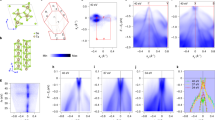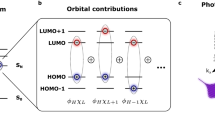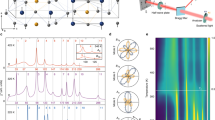Abstract
Excitons, quasiparticles of electrons and holes bound by Coulombic attraction, are created transiently by light and play an important role in optoelectronics, photovoltaics and photosynthesis. They are also predicted to form spontaneously in a small-gap semiconductor or a semimetal, leading to a Bose–Einstein condensate at low temperature, but there has not been any direct evidence of this effect so far. Here we detect the photoemission signal from spontaneously formed excitons in a debated excitonic insulator candidate, Ta2NiSe5. Our symmetry-selective angle-resolved photoemission spectroscopy reveals a characteristic excitonic feature above the transition temperature, which provides detailed properties of excitons, such as the anisotropic Bohr radius. The present result provides evidence for so-called preformed excitons and guarantees the excitonic insulator nature of Ta2NiSe5 at low temperature.
This is a preview of subscription content, access via your institution
Access options
Access Nature and 54 other Nature Portfolio journals
Get Nature+, our best-value online-access subscription
$29.99 / 30 days
cancel any time
Subscribe to this journal
Receive 12 print issues and online access
$209.00 per year
only $17.42 per issue
Buy this article
- Purchase on Springer Link
- Instant access to full article PDF
Prices may be subject to local taxes which are calculated during checkout





Similar content being viewed by others
Data availability
Data that support the plots within this paper and other findings of this study are available from the corresponding author upon reasonable request. Source data are provided with this paper.
Code availability
The numerical computation codes used to obtain the ARPES simulations in Fig. 4c,d are available from the corresponding author upon reasonable request.
References
Lee, H., Cheng, Y.-C. & Fleming, G. R. Coherence dynamics in photosynthesis: protein protection of excitonic coherence. Science 316, 1462–1465 (2007).
Mueller, M. & Malic, T. Exciton physics and device application of two-dimensional transition metal dichalcogenide semiconductors. npj 2D Mater. Appl. 2, 29 (2018).
Kufer, D. & Konstantatos, G. Highly sensitive, encapsulated MoS2 photodetector with gate controllable gain and speed. Nano Lett. 15, 7307–7313 (2015).
Lee, C.-H. et al. Atomically thin p–n junctions with van der Waals hetero-interfaces. Nat. Nanotechnol. 9, 676–681 (2014).
Furchi, M. M., Pospischil, A., Libisch, F., Burgdörfer, J. & Mueller, T. Photovoltaic effect in an electrically tunable van der Waals heterojunction. Nano Lett. 14, 4785–4791 (2014).
Ross, J. S. et al. Electrically tunable excitonic light-emitting diodes based on monolayer WSe2 p–n junctions. Nat. Nanotechnol. 9, 268–272 (2014).
Ye, Y. et al. Monolayer excitonic laser. Nat. Photon. 9, 733–737 (2015).
Butov, L. V. et al. Condensation of indirect excitons in coupled AlAs/GaAs quantum wells. Phys. Rev. Lett. 73, 304–307 (1994).
Liu, X. et al. Quantum Hall drag of exciton condensate in graphene. Nat. Phys. 13, 746–750 (2017).
Wang, Z. et al. Evidence of high-temperature exciton condensation in two-dimensional atomic double layers. Nature 574, 76–80 (2019).
Kogar, A. et al. Signatures of exciton condensation in a transition metal dichalcogenide. Science 358, 1314–1317 (2017).
Sugawara, K. et al. Unconventional charge-density-wave transition in monolayer 1T-TiSe2. ACS Nano 10, 1341–1345 (2016).
Wakisaka, Y. et al. Excitonic insulator state in Ta2NiSe5 probed by photoemission spectroscopy. Phys. Rev. Lett. 103, 026402 (2009).
Wakisaka, Y. et al. Photoemission spectroscopy of Ta2NiSe5. J. Supercond. Nov. Magn. 25, 1231–1234 (2012).
Seki, K. et al. Excitonic Bose–Einstein condensation in Ta2NiSe5 above room temperature. Phys. Rev. B 90, 155116 (2014).
Lee, J. et al. Strong interband interaction in the excitonic insulator phase of Ta2NiSe5. Phys. Rev. B 99, 075408 (2019).
Lu, Y. F. et al. Zero-gap semiconductor to excitonic insulator transition in Ta2NiSe5. Nat. Commun. 8, 14408 (2017).
Fukutani, K. et al. Electrical tuning of the excitonic insulator ground state of Ta2NiSe5. Phys. Rev. Lett. 123, 206401 (2019).
Okazaki, K. et al. Photo-induced semimetallic states realized in electron–hole coupled insulators. Nat. Commun. 9, 4322 (2018).
Kim, M. J. et al. Observation of the soft mode behaviors across the structural phase transition in the excitonic insulator Ta2NiSe5. Phys. Rev. Res. 2, 042039 (2020).
Andrich, P. et al. Ultrafast melting and recovery of collective order in the excitonic insulator Ta2NiSe5. Nat. Commun. 12, 1699 (2021).
Kim, K. et al. Direct observation of excitonic instability in Ta2NiSe5. Nat. Commun. 12, 1969 (2021).
Jerome, D., Rice, T. M. & Kohn, W. Excitonic insulator. Phys. Rev. 158, 462–475 (1967).
Larkin, T. I. et al. Giant exciton Fano resonance in quasi-one-dimensional Ta2NiSe5. Phys. Rev. B 95, 195144 (2017).
Zenker, B., Fehske, H. & Beck, H. The fate of the excitonic insulator in the presence of phonons. Phys. Rev. B 90, 195118 (2014).
Rustagi, A. & Kemper, A. F. Photoemission signature of excitons. Phys. Rev. B 97, 235310 (2018).
Sugimoto, K., Nishimoto, S., Kaneko, T. & Ohta, Y. Strong coupling nature of the excitonic insulator state in Ta2NiSe5. Phys. Rev. Lett. 120, 247602 (2018).
Bronold, F. X. & Fehske, H. Possibility of an excitonic insulator at the semiconductor–semimetal transition. Phys. Rev. B 74, 165107 (2006).
Zenker, B., Ihle, D., Bronold, F. X. & Fehske, H. Electron–hole pair condensation at the semimetal–semiconductor transition: a BCS–BEC crossover scenario. Phys. Rev. B 85, 121102(R) (2012).
Seki, K., Eder, R. & Ohta, Y. BCS–BEC crossover in the extended Falikov–Kimball model: variational cluster approach. Phys. Rev. B 84, 245106 (2011).
Kim, S. Y. et al. Layer-confined excitonic insulating phase in ultrathin Ta2NiSe5 crystals. ACS Nano 10, 8888–8894 (2016).
Larkin, T. I. et al. Infrared phonon spectra of quasi-one-dimensional Ta2NiSe5. Phys. Rev. B 98, 123113 (2018).
Kaneko, T., Toriyama, T., Konishi, T. & Ohta, Y. Orthorhombic-to-monoclinic phase transition of Ta2NiSe5 induced by the Bose–Einstein condensation of excitons. Phys. Rev. B 87, 035121 (2013).
Mazza, G. et al. Nature of symmetry breaking at the excitonic insulator transition: Ta2NiSe5. Phys. Rev. Lett. 124, 197601 (2020).
Baldini, E. et al. The spontaneous symmetry breaking in Ta2NiSe5 is structural in nature. Preprint at https://arxiv.org/pdf/2007.02909.pdf (2020).
Harmanson, J. Final-state symmetry and polarization effects in angle-resolved photoemission spectroscopy. Solid State Commun. 22, 9–11 (1977).
Damascelli, A., Hussain, Z. & Shen, Z.-X. Angle-resolved photoemission studies of the cuprate superconductors. Rev. Mod. Phys. 75, 473–541 (2003).
Watson, M. D. et al. Band hybridization at the semimetal–semiconductor transition of Ta2NiSe5 enabled by mirror-symmetry breaking. Phys. Rev. Res. 2, 013236 (2020).
Ang, R. et al. Real-space coexistence of the melted Mott state and superconductivity in Fe-substituted 1T-TaS2. Phys. Rev. Lett. 109, 176403 (2012).
Tanimura, H., Tanimura, K. & van Loosdrecht, P. H. M. Dynamics of incoherent exciton formation in Cu2O: time- and angle-resolved photoemission spectroscopy. Phys. Rev. B 100, 115204 (2019).
Cui, X. et al. Transient excitons at metal surfaces. Nat. Phys. 10, 505–509 (2014).
Christiansen, D., Selig, M., Malic, E., Ernstorfer & Knorr, A. Theory of exciton dynamics in time-resolved ARPES: intra- and intervalley scattering in two-dimensional semiconductors. Phys. Rev. B 100, 205401 (2019).
Ueta, M., Kanzaki, H., Kobayashi, K., Toyozawa, Y. & Hanamura, E. Excitonic Processes in Solids (Springer, 1986).
Subedi, A. Orthorhombic-to-monoclinic transition in Ta2NiSe5 due to a zone-center optical phonon instability. Phys. Rev. Mater. 4, 083601 (2020).
Nakano, A. et al. Antiferroelectric distortion with anomalous phonon softening in the excitonic insulator Ta2NiSe5. Phys. Rev. B 98, 045139 (2018).
Monney, C. et al. Spontaneous exciton condensation in 1T-TiSe2: BCS-like approach. Phys. Rev. B 79, 045116 (2009).
Monney, C., Monney, G., Aebi, P. & Beck, H. Electron–hole fluctuation phase in 1T-TiSe2. Phys. Rev. B 85, 235150 (2012).
Mu, K. et al. Electronic structures of layered Ta2NiS5 single crystals revealed by high-resolution angle-resolved photoemission spectroscopy. J. Mater. Chem. C 6, 3976–3981 (2018).
Butov, L. V., Gossard, A. C. & Chemla, D. S. Macroscopically ordered state in an exciton system. Nature 418, 751–754 (2002).
Dubin, F. et al. Macroscopic coherence of a single exciton state in an organic quantum wire. Nat. Phys. 2, 32–35 (2006).
Werdehausen, D. et al. Coherent order parameter oscillations in the ground state of the excitonic insulator Ta2NiSe5. Sci. Adv. 4, eaap8652 (2018).
Andrich, P. et al. Imaging the coherent propagation of collective modes in the excitonic insulator candidate Ta2NiSe5 at room temperature. Preprint at https://arxiv.org/pdf/2003.10799.pdf (2020).
Kresse, G. & Hafner, J. Ab initio molecular dynamics for liquid metals. Phys. Rev. B 47, 558–561 (1993).
Kresse, G. & Furthmuller, J. Efficient iterative schemes for ab initio total-energy calculations using a plane-wave basis set. Phys. Rev. B 54, 11169–11186 (1996).
Perdew, J. P. et al. Restoring the density-gradient expansion for exchange in solids and surfaces. Phys. Rev. Lett. 100, 136406 (2008).
Dudarev, S. L. et al. Electron-energy-loss spectra and the structural stability of nickel oxide: an LSDA+U study. Phys. Rev. B 57, 1505–1509 (1998).
Acknowledgements
We thank B.-G. Park for experimental help and C. Park, A. Kemper and A. Rutsagi for fruitful discussions. This work was supported by the Institute for Basic Science (IBS), Korea, under project code IBS-R014-D01 (H.W.Y.), and also by the National Research Foundation of Korea (NRF) through the SRC (no. 2018R1A5A6075964; J.S.K.) and the Max Planck-POSTECH Center (no. 2016K1A4A4A01922028; J.S.K.).
Author information
Authors and Affiliations
Contributions
K.F. and R.S. measured the experimental data. K.F. analysed the data and performed the computations on ARPES spectra simulations. K.J.K. performed the electronic structure calculations. C.I.K. and J.S.K. prepared the samples. H.W.Y. and J.K. were responsible for experimental infrastructures. K.F., R.S. and J.K. maintained the ARPES endstation. K.F. and H.W.Y. wrote the manuscript with input and discussions from the co-authors. H.W.Y. was responsible for overall project planning and direction.
Corresponding author
Ethics declarations
Competing interests
The authors declare no competing interests.
Additional information
Peer review information Nature Physics thanks the anonymous reviewers for their contribution to the peer review of this work.
Publisher’s note Springer Nature remains neutral with regard to jurisdictional claims in published maps and institutional affiliations.
Supplementary information
Supplementary Information
Supplementary Figs. 1–6 and Tables 1–4.
Source data
Source Data Fig. 2
Numerical source data for Fig. 2e–h.
Source Data Fig. 3
Numerical source data for Fig. 3e,f.
Source Data Fig. 4
Numerical source data for Fig. 4b,e,f.
Source Data Fig. 5
Numerical source data for Fig. 5b.
Rights and permissions
About this article
Cite this article
Fukutani, K., Stania, R., Il Kwon, C. et al. Detecting photoelectrons from spontaneously formed excitons. Nat. Phys. 17, 1024–1030 (2021). https://doi.org/10.1038/s41567-021-01289-x
Received:
Accepted:
Published:
Issue Date:
DOI: https://doi.org/10.1038/s41567-021-01289-x
This article is cited by
-
Terahertz parametric amplification as a reporter of exciton condensate dynamics
Nature Materials (2024)
-
Spectral signatures of a unique charge density wave in Ta2NiSe7
Nature Communications (2023)
-
Signatures of the exciton gas phase and its condensation in monolayer 1T-ZrTe2
Nature Communications (2023)
-
Anomalous excitonic phase diagram in band-gap-tuned Ta2Ni(Se,S)5
Nature Communications (2023)



